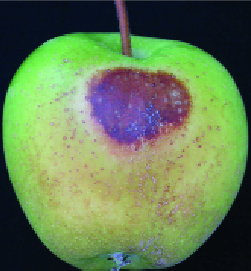Sunburn on apples has been linked to skin disorders—many of which show up later in storage, reducing quality and increasing cullage. Recent studies have identified several disorders and their causes. Many skin disorders are related to environmental stresses of high temperatures and solar radiation, said Dr. Larry Schrader, Washington State University plant physiologist. “Sunburn is usually a major source of cullage.”
Based on cull reports, Schrader estimates that in the state of Washington, between 8 and 12 percent of fruit is lost annually to sunburn damage, a range that he believes is conservative. He said that he believes sunburn is underestimated on packing house cull reports because a recent study showed that on average, while there are 2.5 defects per culled fruit, typically only one defect is reported.
“Even if sunburn damages only 10 percent of the crop, total cost to Washington State growers surpasses $100 million per year,” he stated. When sunburn damage from other states is included in the total amount culled, the losses to growers are staggering.
Schrader, who has collected data on apple skin disorders the past five years, notes that sunburn often leads to other skin disorders. Some appear before harvest, while some come later in storage. Reducing sunburn in the orchard should be a high priority for growers, he said.
Sunburn

Sunburn necrosis on
Golden Delicious

Browning, the most prevalent type of sunburn, on Golden Delicious
Sunburn results from both high fruit surface temperatures and light. Research has identified three types of sunburn: necrosis, browning, and type 3. Sunburn necrosis occurs when the fruit surface temperature reaches 126°F for as little as ten minutes. At this high temperature, skin cells melt, causing thermal death.
Browning, the most prevalent type of sunburn, is induced when fruit surface temperatures reach 114°F to 120°F for one hour. Ultraviolet-B radiation also contributes to browning. Apple varieties differ in their tolerance to sunburn—Cripps Pink Lady is one of the more resistant varieties; Cameo and Honeycrisp are among the most susceptible.
Type 3 sunburn occurs in nonacclimated fruit suddenly exposed to full sunlight. “It’s like taking your shirt off on the first day of summer and getting sunburned,” Schrader explained, adding that exposure can occur during thinning when the top apple is removed, when a tree limb shifts, or bins of picked fruit sit in the sun during transport to the packing house.
Type 3 damage occurs at much lower fruit surface and air temperatures and doesn’t require UV-B radiation. A white bleached area is usually seen within 24 hours of exposure.
Sun-incuced disorders
Fuji staining is a relatively new disorder that shows up during cold storage typically one to four months after harvest. Staining occurs in peripheral areas of a sunburned area as a halo effect. The incidence of staining on Fujis increases as the severity of sunburn increases.
Lenticel marking also appears on the sun-exposed side of fruit, with incidence increasing as sunburn severity increases. Normal, healthy lenticels are white but they become larger and darker when damaged from sunburn. “The lenticel is wide open when it goes through the dump tank,” Schrader said, noting that the lenticel is then predisposed to further breakdown during storage.
Sunburn scald is different than superficial scald because it occurs on the sunburned side of fruit. It has been a problem in Granny Smith apples. Though apples were not severely sunburned, Schrader has seen scald appear later in storage.
Schrader has recently observed two other fruit skin disorders that are not induced by heat or light. These include Fuji flecking and cracking or splitting of apples.
“Fuji flecking was a big problem in a lot of orchards this year,” he commented. In some orchards, he found flecking in up to 70 percent of the crop.
Flecking factors
Factors that cause flecking are not yet well defined, but he said scientists believe the disorder starts early, during rapid expansion of the fruit in the first weeks of its development. As the waxy layer on fruit develops, it cracks or splits, causing fruit to be more susceptible to later flecking.
Research has shown that flecking is more severe in conditions with high humidity. Fruit grown in orchards with overhead irrigation that keeps fruit wet for long periods of time seems to be more prone to flecking, he said, adding that too much evaporative cooling and dense canopies are also associated with flecking.
The causes of apple splitting and cracking are still under investigation. The problem is not unique to Fuji apples, as it also has been observed in Golden Delicious. Preliminary research suggests that damaged lenticels are often the starting point for the crack or split.
“This is another example of why growers need to protect their fruit from heat-induced lenticel marking disorders,” he said. Sunburned fruit are more susceptible to cracking or splitting.






Leave A Comment